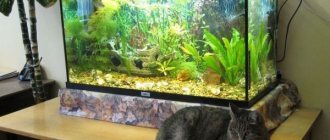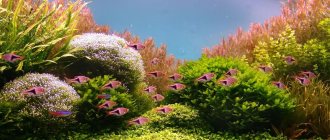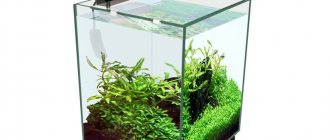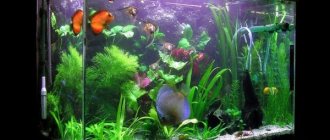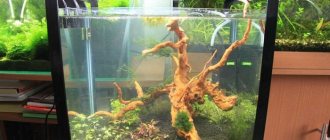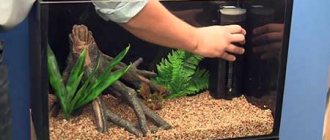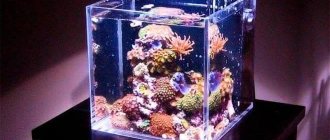Recently, small aquariums have become increasingly popular. And here everything is clear, because not every person has a large apartment in which there is room for a large aquarium. And the aquarium itself and the equipment for it will cost a lot of money. In this regard, with a small container it is much easier, because it can be placed on a desk or on a chest of drawers, and the equipment for it is several times cheaper.
But a 30-liter aquarium also has its drawbacks: the choice of fish for it is smaller than for a large one, and it is difficult to maintain balance in it. Overfeeding or death of a pet can lead to a bacterial outbreak and an increase in nitrate concentrations, which will have a detrimental effect on the fish. Therefore, it is very important not to overfeed hydrobionts and not to overpopulate the aquarium.
Choose a rectangular or square container. Install a small filter and thermostat into it. To make your pets comfortable, plant small plants: sagittaria, cryptocarina Wendt or pontederifolia, marsilia, white-headed stinkhorn, tie moss or anubias to a small branched snag or lava. Let a sprig of hornwort, duckweed or limnobium float on the surface.
How many fish can you put in a 30 liter aquarium?
Information in different sources and the opinions of aquarists about how many fish are permissible to house vary greatly. Each aquarium and fish are unique. The purity of the water, the availability of equipment, plants and the size of the scenery all play a role. Follow the general recommendations and monitor the condition of your pets.
Fish suitable for a 30 liter aquarium:
- Guppy
A quantity of 12 fish will be comfortable in the container. - Neons
The maximum body size is 4 cm. You can have a school of 12 fish. - Danio
The fish are larger than guppies and neons. They settle in the amount of 6 pieces. - Tetras
For 30 liters 6 tetras are enough. Be careful when moving in; tetras, although peaceful, sometimes chase smaller fish. - Cardinals
Cardinal fish are kept in a school of 6 fish. - Betta cockerels
Small individuals are often chosen for stocking in a round aquarium. It is optimal to keep them in 10 pieces. - Swordtails, platies, mollies
Viviparous fish, similar in temperament and size. Allowed to keep 5 individuals. - Barbs
Cherry, scarlet, eight-striped, Sumatran and long-striped fish are stocked with 3 fish per aquarium. For some species of barbs, gregarious living in a spacious aquarium is mandatory. - Rasbory
Small fish are suitable for a small aquarium. They will feel comfortable in the amount of 12 pieces. - Norman's blue eyes
Place these 3cm fish in groups of 12. - Lyalius
A couple of individuals is the optimal amount for 30 liters of water. The maximum size of fish is 8 cm. - Gourami
Species with small sizes (honey, chocolate, dwarf) are housed in groups of 5 individuals. Larger ones (pearl gourami fish, blue, white, marbled or spotted gourami, gold, fiery, neon) are placed in pairs. - Acanthopthalmus fish of Kuehl and Myers
Acantophthalmus Kühl
Acanthophthalmus Myers
A 30-liter aquarium has enough space for one acanthophthalmus. As the fish grows, it reaches 10 cm in length. - Goldfish
A species that leaves a lot of waste and requires attention to water quality. With proper care, you can house one aquarium fish.
The container is suitable for catfish:
- Corridors – 2 pcs.
- Algae eaters – 4 pcs.
- Ancistrus – 1 pc.
In addition to fish, you can add a dozen shrimp:
- Yellow.
- Vishnev.
- Japanese ponds.
- Cardinals.
- Crystals.
Rely on the maximum size of the fish; shrimp that are too small cannot be placed with large fish.
Or you can add up to 10 snails.
You can always combine options.
Aquarium shrimp types with descriptions
Shrimp are not only a decoration for any aquarium, but also aquarium orderlies. Shrimp have become pets only recently, but have already gained immense popularity among both beginners and experienced aquarists. Recently, many different types of aquarium shrimp have been bred by experienced breeders. There are several such types. Let's look at the most popular types of aquarium shrimp:
Shrimp Cherry or Cherry
Cherry or Cherry is one of the most common types of shrimp all over the world, which was bred by breeders from Germany.
It reaches a length of about 4 cm, life expectancy is on average 1-2 years.
The size of the aquarium is from 5 liters for 10 individuals, but for comfort it is better to have 1 liter for 1 Cherry shrimp. They can live at temperatures from +14-30˚С, but a comfortable temperature is from +22-25˚С, acidity from 6.5-8 pH, hardness from 3-10° dH.
The Cherry shrimp is omnivorous: zoo- and phytoplankton on moss, dead parts of plants, corpses of small fish, shrimp pellets, live and frozen food, lightly cooked vegetables.
Blue Dream Shrimp
Blue Dream, the shrimp was named so because of its brightly saturated, very beautiful blue color. The maximum length of a female is 3 cm, a male is 2 cm. Females are larger than males and much brighter in color. Very unpretentious in breeding and maintenance, suitable for breeding for beginning aquarists.
It feeds on aquarium algae and the remains of flakes of fish food, feeding once a day with dry food for shrimp or bottom fish.
Temperature for keeping from +22-26° C, acidity from 6.5-8 pH, hardness from 5-18° dH. When kept in the required conditions, the lifespan is up to 2 years.
Shrimp Cardinal
The Cardinal shrimp reaches 1.5-2 cm. Natural habitat of the lake of the Sulawesi islands, Indonesia. The content of Cardinal is quite complex, since its maintenance requires a temperature of +26-29°C, acidity from 7.8-8.2 pH, potassium hydride from 7-9 kH, alkalinity from 7-9 gH, water salinity from 90-140 TDS, hardness 7° dH.
From the editor: Compatibility of aquarium fish
The substrate for the aquarium should be soil with a size of 3-4 mm with an abundance of aquarium plants and especially mosses. There is also an abundance of stones that serve as a home.
Life expectancy 1 year.
Plants
Plants are needed for natural filtration and to create shade for secretive fish. Greens are involved in many biological processes taking place in a body of water, for example, absorbing carbon dioxide or harmful inorganic compounds. Beautiful and unpretentious plants:
- Elodea;
- Cryptocoryne;
- Java moss;
- Hornwort;
- Heteranthera doubtful;
- Yakut.
Catfish: how to distinguish a male from a female
To successfully breed aquarium catfish, it is necessary to distinguish females from males. There are a number of criteria that allow you to correctly perform this task, but each species has its own differences between male and female:
body dimensions. Female representatives are much larger than males; growths on the face
The male, as a rule, has growths (antennae), but the female does not; the abdominal line has a course directed towards the bottom; The color of males is always much brighter than that of females; Owners should also pay attention to the area of the abdominal line located near the anus. Females have a characteristic depressed pit, while males have a small tubercle.
Of course, in this case the list of criteria is incomplete. A number of sexual differences are strictly specific for each type of aquarium catfish. It is better to clarify these features with specialists - ichthyologists or sales consultants when purchasing catfish.
Decor
When setting up a 30-liter aquarium, study the conditions for keeping the fish. Remember that bright and contrasting fish look great against a dark background. Some fish species are sensitive to angular stones and jewelry.
Stones
You can collect mineral rocks from nature. It is important that aquarium rocks do not contain limestone. You can test the stones by dropping vinegar on them. If a reaction occurs with the release of bubbles, the stone is unsuitable. Having purchased it in a store or found stones in nature, rinse with a brush and boil. Quartz, granite and flint are suitable.
Shells
They also increase water hardness.
driftwood
Like stones, they can be collected in the forest. Look for wood in places with favorable ecology. Driftwood that has been in the water for a long time is suitable. After collection, boil for an hour. Read more about driftwood in an aquarium in a separate article.
Ceramic jugs and pots
Avoid materials used in gardening. Dishes for the needs of the aquarium must be new.
Glass
Such decorative elements are completely suitable for an aquarium. Make sure that objects are not painted on the outside, as the dye is poisonous to fish.
Metal jewelry
They are rarely used for arranging a home pond: metal spoils the composition of the water. It is possible to use elements made of stainless steel and aluminum alloys.
Kinds
Goldfish are divided into two broad categories:
- Long-bodied individuals - prominent representatives are the comet or wakin. The long-bodied individuals resemble crucian carp in shape and are long-lived.
- Short-bodied - this group is characterized by a body compressed from head to tail. Representatives are the fruit of selection work; a prime example is a telescope or a pearl. These goldfish require more effort and time to care for and maintain than longer-bodied ones.
Despite the fact that there are many varieties of goldfish, not all are extremely popular. Each species differs from each other in the type of scales, shape of fins and eyes, so before purchasing you should carefully study the descriptions of common varieties.
Regular fish
The common aquarium goldfish is the most common inhabitant of artificial reservoirs. The phenotype color is golden-red, but can be yellow, white or black. Representatives of this species are descendants of wild crucian carp, so similar features are clearly visible in the appearance of both fish.
Wakin
The Wakin breed was bred by Japanese breeders and is distinguished by its large dimensions: the size of the fish reaches 30 cm. The body is painted scarlet or milky, but there are specimens that combine both shades.
From the editor: Lunar gourami
Riukin
Riukin are unusual fish with a curved body, which is why individuals have a small hump. Among the different color options, the most popular are red, white and calico riukin goldfish. Representatives of the species tolerate being kept in small aquariums better than other relatives.
Comet
Comet is a popular aquarium goldfish that is easy to keep and care for. But breeding a comet in captivity is difficult. The phenotype has a long caudal fin, which consists of two ribbons. Representatives reach 15 cm in length. The color of comets can be different, but specimens with different colors of fins and body are most valued: for example, scarlet fins and a silver body.
Veiltail
Golden veiltails have a very original appearance: a spherical body, a large head and a luxurious, bushy tail. Veiltails grow up to 20 cm in length and are painted in bright colors: variegated, golden, light.
Pearl
Pearls are small fish, only 7-8 cm long. The specimen received its beautiful name for its unusual scales: each dome-shaped plate is surrounded by a dark border, which from a distance resembles a pearl. The color can be golden, scarlet-orange, white. Keeping pearl goldfish is not suitable for beginners, as this species is capricious and prone to various diseases.
Astrologer
Stargazer, or celestial eye, is a stunning fish with unusual eyes that are constantly directed upward. The species is divided into two subspecies: long-bodied and short-bodied fish. The color is golden-orange, and the most expensive are those with golden irises.
Oranda
The oranda, or goose head, gets its name from the growths on its gills and head. The color of the fish can be varied: coffee, calico, black, etc. The most valuable is the oranda with a scarlet hood, from which another variety was bred - the red cap.
Telescope
The telescope, or water dragon, is an unusual fish with a rounded body and an erect dorsal fin. The remaining fins are veil, the color is varied: orange, black and white, dark, scarlet. A distinctive feature of telescopes is considered to be expressive eyes with transparent irises protruding above the skull.
Shubunkin
The Shubunkin fish stands out from other species with its color, which combines yellow, dark, light, violet and scarlet. For such a palette, shubunkins are called calico fish.
Equipment
It is better to purchase a rectangular container. A round vessel is difficult to maintain and inconvenient for fish. The following supplies and equipment will be needed.
Equipment
Filter
There is external and internal. For a 30-liter container, an internal device with a power of 25–40 W is suitable. A device that is too powerful will create strong water pressure and cause stress to aquatic life. Place the internal filter on the wall, immersing it in 3-4 cm of water. Rinse the filter with aquarium water once a week, then the bacterial balance will not be disturbed. Replace the filter material as it wears out.
Lamp
When buying an aquarium, think about what the lighting will be like and how to place it. It is convenient if the cover is equipped with a lamp socket. Give preference to LED, metal halide lamps and take into account the needs of plants. The minimum lamp power for unpretentious plants is 0.3 W/liter. Choose light sources in the red and blue spectrum.
It is better not to use incandescent lamps due to low performance and strong heating of the liquid.
Thermometer
Helps monitor water temperature
Heater
In winter, you will need a heater, which is especially necessary for heat-loving fish.
Compressor
The device saturates the water with oxygen. The device looks like a box to which a hose with a sprayer is connected. The compressor is located outside the aquarium, the hose is immersed in water. Often components are sold separately.
Feeders
Keeps the aquarium clean and does not allow food to spread out. Develops a habit for pets to eat in a certain place.
Aquarium installation
- A new aquarium can be washed with tap water to remove dust and dirt.
- Place the container on a sturdy, level surface, first placing a protective pad over it.
- The soil must be pre-rinsed (unless otherwise indicated in the instructions for use). Pour it into a clean bucket, fill it with tap water and stir. The procedure is repeated several times until the water is sufficiently clear.
- The soil is poured into the aquarium and placed along its bottom as desired. Decorations, driftwood, stones, etc. are placed.
- Fill with water that has been pre-treated with conditioner to remove chlorine. You will need about 3-4 buckets of water.
- Install a filter, heater, thermometer.
- Live plants can be planted when the aquarium is filled with water.
Content
For cleaning you need:
- net for catching fish;
- siphon for soil cleaning;
- glass scraper.
Weekly maintenance of the aquarium takes place in 4 stages:
- soil siphon;
- quarter water change;
- equipment washing;
- cleaning glass from plaque.
Get a second aquarium for quarantine, fish spawning and a nursery for the young. Another spacious container will do. After purchasing a fish, do not immediately place your new neighbor in a common aquarium. Keep your new pet in a quarantine container for several weeks. If the fish does not show signs of illness, you can add it to the others. Neglecting quarantine puts the lives of the inhabitants of the reservoir at risk, because most diseases are introduced with new fish. Sick fish are also kept in a quarantine tank where they undergo treatment.
If fish breeding occurs, then a couple of breeders are deposited. Some fish show aggression towards others during spawning. The additional capacity will allow the fry to grow separately from their parents and not be eaten.
Tosakin - goldfish
Tosakin goldfish photo
The main value of the Tosakin Goldfish is its large fan-shaped tail fin, which reaches its greatest extent in the horizontal plane, so all the beauty of the fish is revealed when viewed from above, and not from the side. Body color varies from red to silver in various combinations, and there is also a variety with a dark metallic tint.
Tosakin goldfish photo
Tosakin goldfish photo
The structure of the tail, coupled with the short, heavy body, does not contribute to the gracefulness of movements, which is why Tosakin swims very clumsily. Similar features determined the requirements for the arrangement of the aquarium; it should be shallow with standing water; any internal current, even weak, is unacceptable. Otherwise, it is unpretentious and differs little in maintenance from its relatives, such as Ryukin, Ranchu, Lionhead, etc.
Tosakin goldfish photo
There is no reliable information about the origin of this breeding variety of goldfish, there are several versions, one more beautiful than the other, but if we speak in summary, this is the story - Tosakin was first bred in medieval Japan and until the mid-twentieth century did not leave the borders of its native province, now it is Kochi Prefecture. Large-scale destruction of the prefecture's cities in 1945 during the American bombing and a major earthquake in 1946 almost completely destroyed the Tosakins. One collector named Hiroe Tamura managed to find six surviving fish in a restaurant in Kochi and exchange them for a bottle of potato vodka.
Thus, all modern representatives of this species are direct descendants of these last six surviving fish.
conclusions
- When starting a thirty-liter aquarium, be careful about its maintenance. There is no established biological environment in a small volume, so you need to monitor the purity and parameters of the water.
- Decide in advance which fish to put in the 30-liter aquarium. Take care of the compatibility of temperament and water parameters.
- Do not overcrowd the aquarium, because diseases spread when there is not enough free space. Aggression from some species also occurs in close quarters.
- Monitor the health and behavior of the aquarium inhabitants. If fish gather in groups near the surface, this indicates a lack of oxygen. You will need a compressor and additional plants.
- Inspect and count fish while feeding.
Previous
AquariumHow to clean an aquarium: 8 steps for proper cleaning
Next
AquariumWhy is a round aquarium absolutely not suitable for goldfish?
Tosakin - goldfish
The main value of the Tosakin Goldfish is its large fan-shaped tail fin, which reaches its greatest extent in the horizontal plane, so all the beauty of the fish is revealed when viewed from above, and not from the side. Body color varies from red to silver in various combinations, and there is also a variety with a dark metallic tint.
The structure of the tail, coupled with the short, heavy body, does not contribute to the gracefulness of movements, which is why Tosakin swims very clumsily. Similar features determined the requirements for the arrangement of the aquarium; it should be shallow with standing water; any internal current, even weak, is unacceptable. Otherwise, it is unpretentious and differs little in maintenance from its relatives, such as Ryukin, Ranchu, Lionhead, etc.
There is no reliable information about the origin of this breeding variety of goldfish, there are several versions, one more beautiful than the other, but if we speak in summary, this is the story - Tosakin was first bred in medieval Japan and until the mid-twentieth century did not leave the borders of its native province, now it is Kochi Prefecture. Large-scale destruction of the prefecture's cities in 1945 during the American bombing and a major earthquake in 1946 almost completely destroyed the Tosakins. One collector named Hiroe Tamura managed to find six surviving fish in a restaurant in Kochi and exchange them for a bottle of potato vodka.
Thus, all modern representatives of this species are direct descendants of these last six surviving fish.
We recommend using Prodibio Aqua'Gold and Gold'Activ - a conditioner and biological culture developed specifically for cold-water fish. Why in ampoules, we wrote about this in more detail here, take a look.
Useful video about goldfish
How to save yourself the hassle of caring for an aquarium?
Regardless of the size of the aquarium, it requires regular cleaning and maintenance. During the water change, some purification of organic matter occurs; a glass tube, a net and even a hose also help to cope with clogging. In addition, there are natural “cleaners” - snails, which can also be added to the fish. In any case, should I clean the aquarium and top it up? fresh, settled water is recommended at least once every 7-10 days.
To select an aquarium that suits your capabilities and preferences, as well as for regular professional maintenance of your quiet home backwater, you need to contact specialists. Competent selection of housing for your fish, installation of equipment of the required level of functionality and timely inspection, prevention and repair - this is what the experienced employees of our company will delight you with. Call ((495) 506–05–48, 366-74-56) or write ( [email protected] or [email protected] ) to us to order an aquarium or its maintenance!
Is it possible to add shrimp?
Given the delicate temperament of golden pets, they can choose not only fish, but also other underwater animals as neighbors. For example, large-sized shrimp, having a character similar to scrofula, will make an excellent tandem.
The shrimp will cleanse the common dwelling from waste products of golden “dirt”, which they produce in large quantities. At the same time, the aquarium will take on an exotic look, especially if you add shrimp of various colors to it. It is important that they are not small and cannot fit into the mouths of golden gluttons.
Goldfish can get along well with shrimp in the same aquarium
Caring for large aquariums (approx. 200 liters)
An aquarium with a capacity of 200 liters allows you to keep a wide variety of species - the main thing is that sufficient volume is provided for each individual and that the selected species get along together. It would be optimal to populate such an aquarium with labyrinthine, viviparous fish, most species of cichlids, silversides, argus, splash fish, catfish, and loaches. Characins, wedge-bellies and piranhas will also decorate your aquarium. However, it is not recommended to populate even such a large aquarium too actively - 30-35 fish are quite enough if at least a third of them are quite small.
Compatibility table
All representatives belonging to goldfish are incredibly beautiful. It is not surprising that their owners want to house several different species in one home. You can determine the possibility of adding a particular individual using a table that will tell you about the compatibility of pets.
| Fish name | Compatibility with Carassius auratus | ||
| Compatible | Conditionally compatible | Absolutely incompatible | |
| Angelfish | X | ||
| Barbs | X | ||
| Cockerels | X | ||
| African aquarium fish cichlids | X | ||
| American cichlids | X | ||
| Catfish cockroaches | X | ||
| Soma Corydoras | X | ||
| Danio | X | ||
| Guppy | X | ||
| Gourami | X | ||
| Goldfish | X | ||
| Koi carp | X | ||
| Neon | X | ||
| Mollies | X | ||
| Rasbory | X | ||
| Rainbows | X | ||
| Labeo | X | ||
| Swordtails | X | ||
| Shrimps | X | ||
| Tetras | X | ||
| Discus | X | ||
| Botsiya | X | ||
| Akara | X | ||
| Ancistrus | X | ||
| Astronotus | X | ||
| Lyalius | X | ||
| Macropod | X | ||
| Melanochromis | X | ||
| Tropheus | X | ||
| Pecilia | X | ||
| Pristella | X | ||
| Nothobranchus | X | ||
In addition, pay attention to population density. For example, in one 100 liter aquarium it is allowed to contain no more than 2 scrofula. To determine the number of other fish, use a special calculator.
